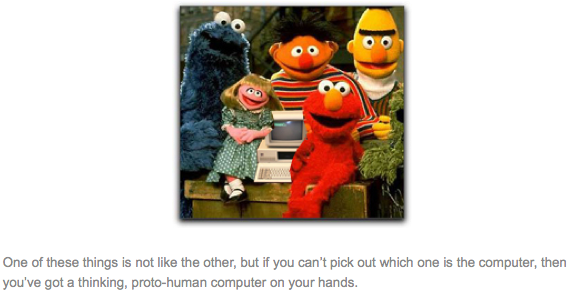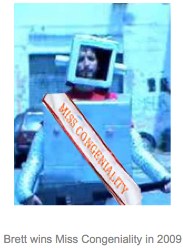By Dennis Baron
 Each year there’s a contest at the University of Exeter to find the most human computer. Not the computer that looks most like you and me, or the computer that can beat all comers on Jeopardy, but the one that can convince you that you’re talking to another human being instead of a machine.
Each year there’s a contest at the University of Exeter to find the most human computer. Not the computer that looks most like you and me, or the computer that can beat all comers on Jeopardy, but the one that can convince you that you’re talking to another human being instead of a machine.
To be considered most human, the computer has to pass a Turing test, named after the British mathematician Alan Turing, who suggested that if someone talking to another person and to a computer couldn’t tell which was which, then that computer could be said to think. And thinking, in turn, is a sign of being human.
Contest judges don’t actually talk with the computers, they exchange chat messages with a computer and a volunteer, then try to identify which of the two is the human. A computer that convinces enough judges that it’s human wins the solid gold Loebner medal and the $100,000 prize that accompanies it, or at least its programmer does.
Here are some excerpts from the 2011 contest rules to show how the test works:
 Judges will begin each round by making initial comments with the entities. Upon receiving an utterance from a judge, the entities will respond. Judges will continue interacting with the entities for 25 minutes. At the conclusion of the 25 minutes, each judge will declare one of the two entities to be the human.
Judges will begin each round by making initial comments with the entities. Upon receiving an utterance from a judge, the entities will respond. Judges will continue interacting with the entities for 25 minutes. At the conclusion of the 25 minutes, each judge will declare one of the two entities to be the human.
At the completion of the contest, Judges will rank all participants on “humanness.”
If any entry fools two or more judges comparing two or more humans into thinking that the entry is the human, the $25,000 and Silver Medal will be awarded to the submitter(s) of the entry and the contest will move to the Audio Visual Input $100,000 Gold Medal level.
Notice that both the computer entrants and the human volunteers are referred to in these rules as “entities,” a word calculated to eliminate any pro-human bias among the judges, not that such a bias exists in the world of Artificial Intelligence. In addition, the computers are called “participants,” which actually gives a bump to the machines, since it’s a term that’s usually reserved for human contestants. Since the rules sound like they were written by a computer, not by a human, passing the Turing test should be a snap for any halfway decent programmer.
 But even though these Turing competitions have been staged since 1991, when computer scientist Hugh Loebner first offered the Loebner medal for the most human computer, so far no computer has claimed the go
But even though these Turing competitions have been staged since 1991, when computer scientist Hugh Loebner first offered the Loebner medal for the most human computer, so far no computer has claimed the go


